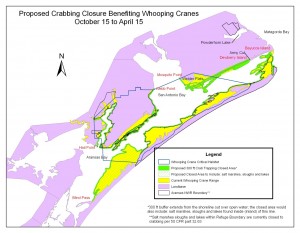Whooping Crane Conservation Association president Lorne Scott sent letter to Texas Parks and Wildlife Department Executive Director Carter Smith requesting measures to help ensure adequate food source for whooping cranes. President Scott advises,”The Whooping Crane Conservation Association (WCCA) has been working to help whooping cranes for over 60 years. Since blue crabs are the main food source for wintering whooping cranes at Aransas, we are concerned with the long-term decline of blue crabs Gulf-wide, including the Texas coast. Specifically, we urge your Department to institute a seasonal closure on blue crab harvest in areas used by wintering whooping cranes.”
In 2009, personnel of Texas Parks and Wildlife Department (TPWD -Fisheries and Regulatory divisions) and Aransas National Wildlife Refuge (NWR) met several times and developed a proposal to expand the crab closure zone to all marshes currently being used by wintering whooping cranes. Also proposed was a closure 300 feet out from the marshes in the shallow parts of the bays where whooping cranes may forage. With crabbing currently prohibited on Aransas and Matagorda Island NWRs, the proposal would affect marshes on San Jose Island, Welder Flats and Lamar as well as bay edges throughout the crane area. This proposal would increase availability of blue crabs for wintering whooping cranes, reduce disturbance to the cranes, and would reduce the problem of traps being abandoned in the shallow marshes. The proposed closure would be seasonal in nature only for when the cranes are on the Texas Coast from October 15th through April 15th.
Your Department wanted to collect additional information on exactly how many licensed crab fisherman would be impacted, but this was never completed. TPWD personnel subsequently decided not to present this matter to your Commission, and the proposal was dropped.
The WCCA requests that TPWD re-consider this matter and bring it before the Commission. The closure would impact only a handful of commercial crabbers; it would reduce the problem of crab traps being placed in the shallow marshes and later abandoned when tides become too low to check traps; and it would signal the Department’s concern about the blue crab resource and the endangered whooping crane. In 2009, the Aransas NWR began to enforce a closure of the crab fishery on Matagorda Island. A similar move by TPWD for the crane areas including San Jose Island, Welder Flats and Lamar would benefit whooping cranes by increasing their food supply. It makes little sense to be trapping crabs during the whooping crane season (October 15 to April 15) since low tides during the winter make most of the marshes and bay shorelines inaccessible with fisherman unable to access traps. A seasonal closure would also reduce disturbance to whooping cranes, an issue of increasing concern as more and more people are able to access even the shallowest of marshes with kayaks and airboats.
A map of the seasonal proposed closure as discussed in 2009 is attached. We urge your Department to bring this matter to your commission for passage.


